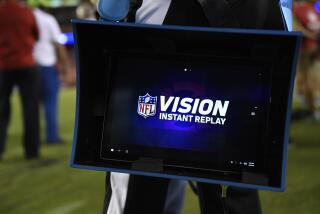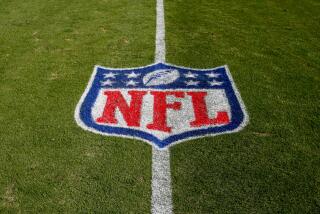Study Looks at Hits to Head
BLACKSBURG, Va. — Football players were struck in the head 30 to 50 times per game and regularly endured blows similar to those experienced in automobile accidents, according to a Virginia Tech study that fitted players’ helmets with the same kinds of sensors that trigger auto air bags.
University researchers are compiling a database of blows to the head their starting players endured this year, with plans to study how much trauma the brain can take.
The study adds to a growing body of research into concussions, the blows to the head that played a role in ending the careers of NFL quarterbacks Troy Aikman of the Dallas Cowboys and Steve Young of the San Francisco 49ers, among others.
The data so far surprised team physician P. Gunnar Brolinson, who said he didn’t realize players were absorbing so many serious hits, especially since only about five came off the sidelines this season with concussions.
“There are probably factors that we don’t fully understand that make players better able to withstand higher accelerations [football hits] than other people,” he said.
It’s possible that some players can withstand stronger blows because they have stronger neck and shoulder muscles or that they’re simply more robust genetically than others, Brolinson said.
The researchers recorded 3,312 hits during 35 practices and 10 games this season, rotating eight specially fitted helmets among 38 players. Project leader Stefan Duma said offensive linemen endured the most hits, followed by defensive linemen, running backs, linebackers, wide receivers and defensive backs. Quarterbacks recorded the fewest hits.
“If you ask somebody what kind of head injury are you going to worry about, everybody thinks of the receiver running down the sideline getting popped by the safety,” Duma said. “But to me, the interesting part is going to be these lower speed but high frequency hits we’re seeing on the [offensive and defensive] line. The fact that these players are getting headaches all the time after every game, there’s something going on there.”
Duma, an engineer who specializes in car crashes and safety equipment, plans to use the data to improve protective gear for players. The data also could help researchers understand and prevent concussions, a common condition in college football that can be hard to diagnose.
The helmets measure hits in multiples of the force of gravity. Half of the hits recorded this season were greater than 30 Gs, Duma said. The hardest hits measured more than 130 Gs.
“An impact of 120 Gs would be like a severe car accident, which you could survive if you were wearing a seat belt,” Duma said.
Duma said Tech plans to expand the program using more helmets. With enough monitoring, he said, medical staffs should be able to reduce football concussions by accurately predicting the number and degree of blows a player can handle.
More to Read
Go beyond the scoreboard
Get the latest on L.A.'s teams in the daily Sports Report newsletter.
You may occasionally receive promotional content from the Los Angeles Times.










